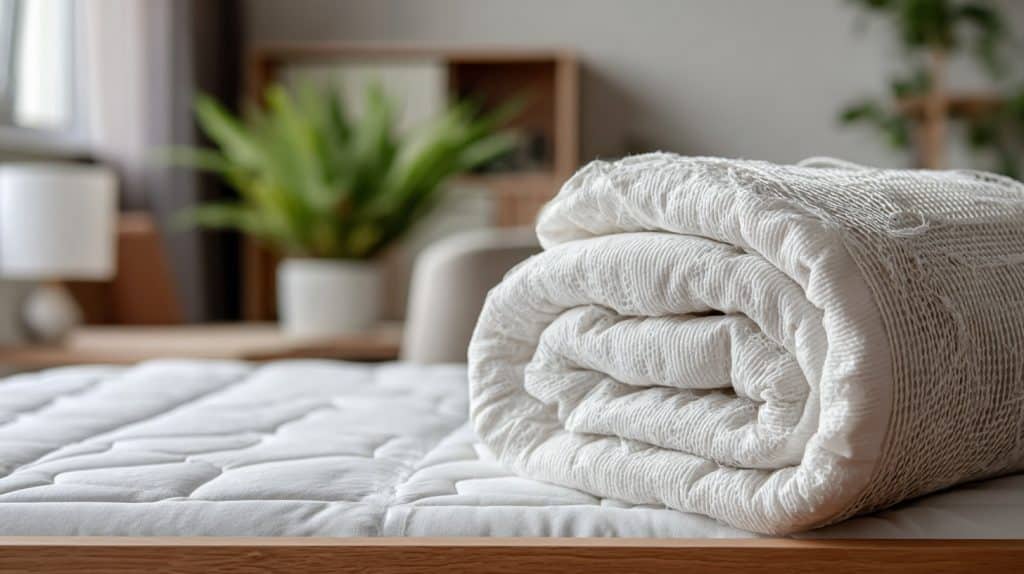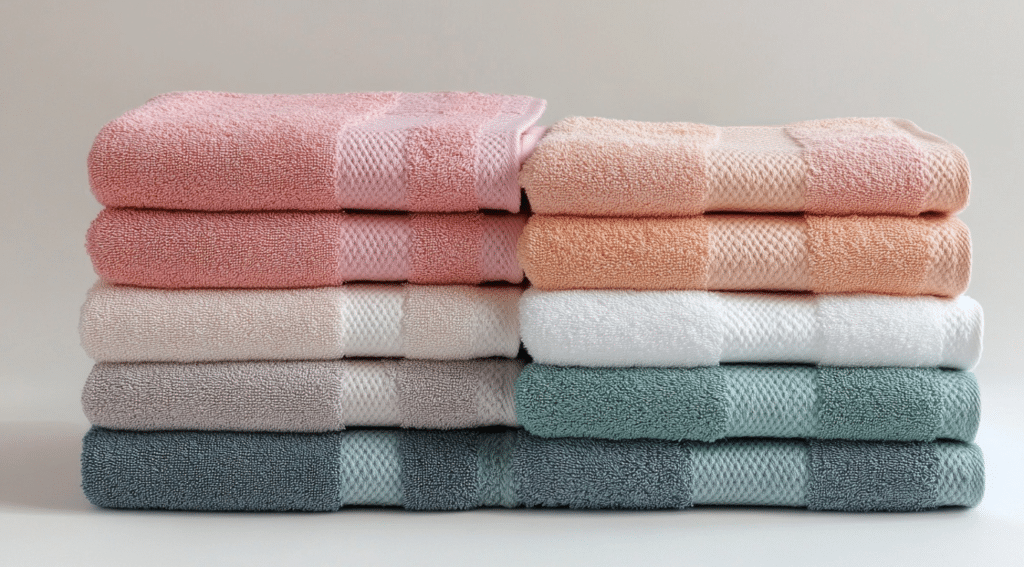Ever packed away a mattress topper and later found it musty, misshapen, or flat? I’ve seen it happen more than once, and it’s frustrating. The same issues arise when people aren’t sure how to store a mattress topper, including moisture, pests, and lost comfort.
Before you put your topper away, a little prep goes a long way:
- Remove all bedding and give the topper a full surface clean.
- Spot clean any stains so they don’t set over time.
- Make sure it’s completely dry to avoid mold and odor.
- Check for signs of wear or damage before storing.
A few extra minutes now will help your topper stay fresh, supportive, and ready for use when you need it again.
Preparing Your Mattress Topper for Storage
Before you store your mattress topper, take time to prepare it properly. This helps keep it fresh, clean, and ready to use when you need it again. Start by removing all bedding and giving the topper a full surface clean.
Check for any spots or stains and treat them right away so they don’t set while in storage. Make sure the topper is fully dry before packing to prevent moisture-related problems. Finally, inspect it for any signs of wear, damage, or unpleasant smells.
Addressing these issues now will help protect the topper’s condition and extend its life, so it stays supportive and comfortable the next time you put it on your bed.
Storage Methods for Your Mattress Topper
Selecting the correct storage method helps maintain shape, prevent damage, and keep your topper in good condition. These tips also apply if you’re deciding how to store a mattress.
Rolling to Protect Foam
Rolling is the safest way to store memory foam and latex toppers. It prevents deep creases and minimizes pressure points that can cause permanent indentations. Start at one end and roll evenly without bending the material sharply.
Secure with soft straps or bands, making sure not to overtighten. Store the rolled topper in a protective cover to keep it free from dust.
Loose Folding for Down/Feather Toppers
Down and feather toppers can be loosely folded without risking damage. This method works well when storage space is limited. Avoid pressing or squashing the folded topper, as this can reduce loft and comfort.
Place it in a breathable cotton bag to protect it from dust and pests. Store in a cool, dry space away from heavy items to maintain its fluff.
Light Vacuum Sealing (Short Term Only)
Vacuum sealing can save space, but it should only be used for short-term storage. Prolonged compression can damage foam cells and reduce support. If using this method, ensure the topper is fully dry and clean.
Use a high-quality vacuum-seal bag, remove just enough air to compress slightly, and store in a temperature-controlled space to avoid heat or moisture damage.
How to Store a Mattress Topper: Step-by-Step Guide
Follow these steps to keep your mattress topper safe, clean, and in top condition for long-term storage and future use.
Step 1: Protect the Topper
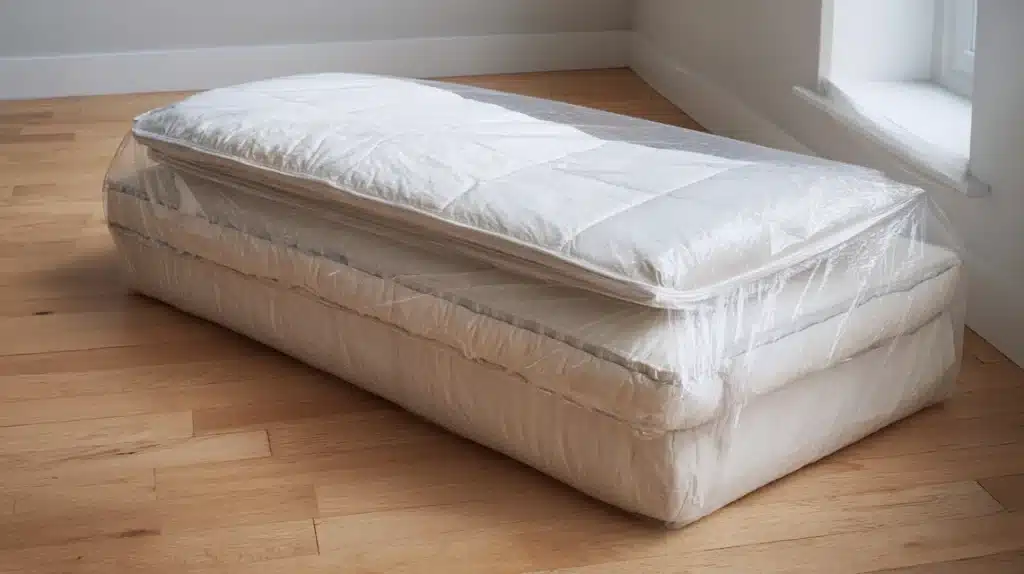
Shielding your topper from dust, pests, and odors is essential. Place it inside a quality storage bag or heavy-duty plastic cover to block debris. For down toppers, a breathable cotton bag allows airflow and prevents moisture buildup.
Add pest deterrents like cedar blocks or lavender sachets to keep insects away. Proper protection during storage ensures the topper remains fresh, clean, and free from damage when it’s time to use it again.
Step 2: Pick the Storage Location
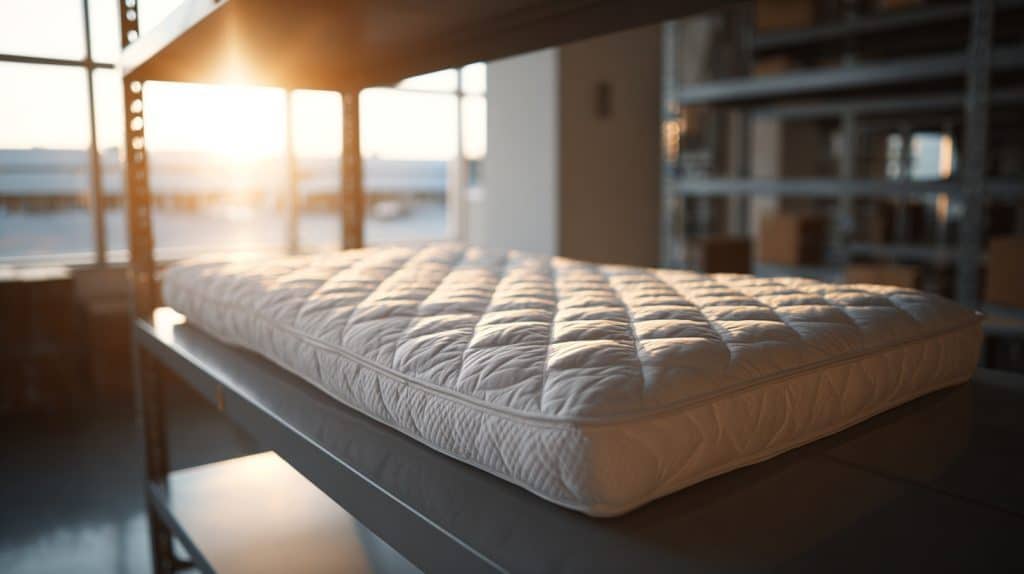
Choosing the right spot is key to maintaining your topper’s shape and condition. A climate-controlled space helps prevent mold, mildew, and temperature damage. Avoid storing in damp basements or hot attics, where extreme conditions can break down materials.
Keep the topper out of direct sunlight to prevent discoloration and fabric weakening. A cool, dry, dark area will preserve your topper’s comfort and extend its lifespan significantly.
Step 3: Secure, Label, and Store
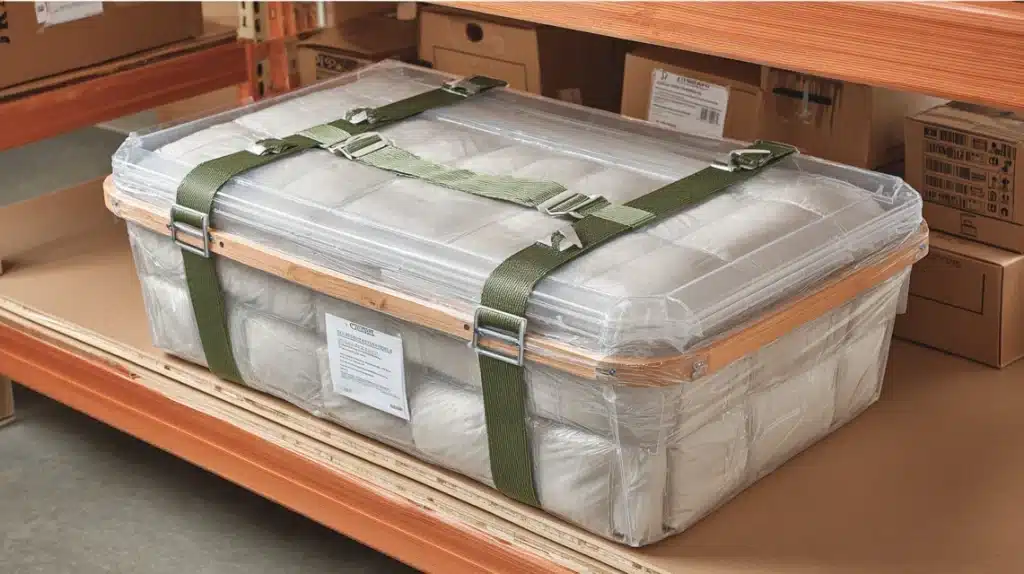
Once the topper is protected, secure it with soft straps or bungee cords to maintain its shape without causing indentations. Add a clear label with the storage date, size, and material type for easy identification later.
Store it in a location where it won’t be crushed under heavy objects. Proper securing and labeling make retrieval simple and ensure the topper stays in the same condition as when stored.
Step 4: Long-Term Checks
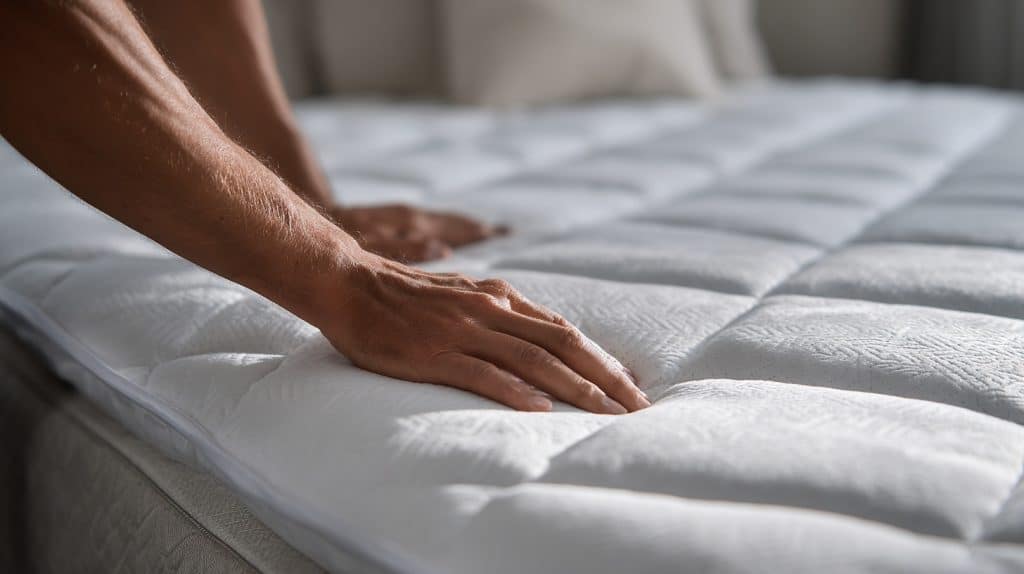
Regular inspections keep your topper in excellent shape during extended storage. Every four to eight weeks, check for moisture, pests, or odors. If needed, air it out for a few hours to refresh the fabric and prevent stale smells.
Rotate the topper occasionally to avoid permanent compression marks. These small maintenance steps help protect the topper’s structure and keep it ready for immediate use at any time.
Step 5: Refresh Before Reuse
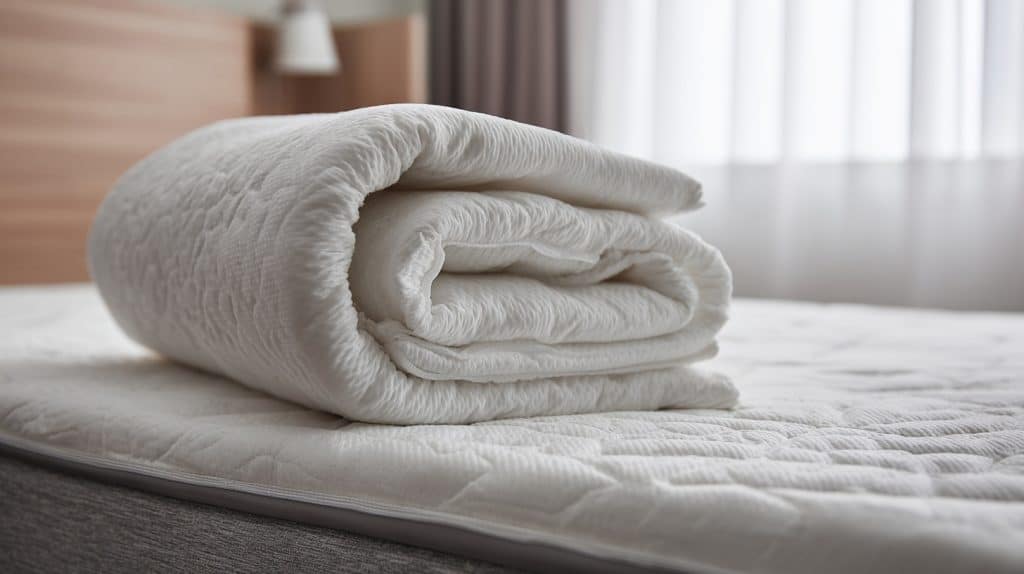
When you’re ready to use your topper again, give it time to regain its full comfort and freshness. Unroll it and let it rest for twenty-four to forty-eight hours so it can re-expand fully.
For a quick refresh, sprinkle baking soda over the surface, let it sit, then vacuum it off. Finally, air the topper near an open window to remove any lingering storage odors.
Year-Round Storage Strategies
Adjusting storage for the season helps protect your mattress topper and maintain comfort over time.
Summer Storage (Climate Control + Silica Gel Packs): High summer heat and humidity can weaken materials. Keep your topper in a climate-controlled area to prevent warping. Add silica gel packs inside the storage bag to absorb excess moisture. Avoid direct sunlight and heat sources to keep the topper from breaking down.
Winter Storage (Avoid Freezing Areas): Cold temperatures can stiffen foam and latex. Store your topper in an indoor space that stays above freezing. Keep it off concrete floors by placing it on shelving or pallets to prevent cold damage.
Humid Regions (Cotton Covers + Monthly Inspections): In high-humidity areas, use a breathable cotton storage cover to allow airflow. Add moisture absorbers nearby to limit dampness. Inspect the topper once a month for signs of mold or pests to catch problems early.
Mattress Topper Storage Based on Materials
Different mattress topper materials need different storage approaches to maintain their shape, comfort, and lifespan over time.
| Material | Best Method | Climate Tips | Extra Precautions |
|---|---|---|---|
| Memory Foam | Roll, No Folding | Cool, Dry | Avoid Long Vacuum Seals |
| Latex | Roll Loosely | Moderate Humidity | Keep Out of Sun/Heat |
| Down/Feather | Loose Fold or Roll | Low Humidity | Use Breathable Cotton Cover |
Choosing the correct method for your topper type protects it from damage, helps it stay fresh, and extends its usable life.
Pest Prevention Tips
Keeping pests out of your stored mattress topper protects it from damage and keeps it fresh for reuse.
- Seal Storage Bags Fully: Make sure zippers, seams, and closures are completely shut. Use packing tape over seams if needed to block insects.
- Add Natural Repellents: Place cedar blocks or lavender sachets inside the storage bag or nearby to deter moths and other pests.
- Inspect Regularly: Check the topper and storage bag every month for any signs of pest activity and take action immediately if spotted.
By taking these steps, you can keep pests away and ensure your mattress topper stays clean and ready to use.
Product Comparison Table
Choosing the right storage accessory helps protect your mattress topper, save space, and maintain its condition until you need it again.
| Product Type | Best For | Pros | Cons |
|---|---|---|---|
| Breathable Storage Bag | Down/Feather toppers | Airflow prevents mildew | Not fully pest-proof |
| Airtight Storage Bag | Short-term foam storage | Complete dust/pest protection | Can trap moisture |
| Vacuum-Seal Bag | Small spaces/dorm storage | Saves space, pest-free | Foam compression risk long-term |
| Straps/Bungee Cords | Any rolled topper | Secure hold, inexpensive | Risk of over-compression |
Selecting the right product ensures your topper stays clean, protected, and in good shape throughout its entire storage period.
Common Mistakes to Avoid
Avoiding these mistakes will keep your mattress topper in good condition and extend its usable life during storage.
- Folding foam or latex: Creates permanent creases, weakens the structure, and can cause cracks in the material. Always roll instead.
- Storing while damp: Traps moisture, leading to mold, mildew, and unpleasant odors that are difficult to remove. Dry completely first.
- Long, tight vacuum seals on foam: Prolonged compression damages foam cells, reducing comfort and support. Limit to short-term storage.
- Storing in hot or damp areas: Extreme temperatures and moisture break down materials and encourage mold growth. Use climate-controlled spaces.
- Avoid Heavy Stacking: Stacking heavy items on top Causes deformation, flattening, and uneven wear. Keep the topper free from weight to maintain its shape.
Steering clear of these mistakes will help your mattress topper stay comfortable, supportive, and ready for use when you need it.
Wrapping Up
Knowing how to store a mattress topper properly can make a big difference in keeping it clean, comfortable, and lasting longer.
I’ve found it really comes down to matching your storage method to your topper type, available space, and climate, so it actually works for you.
I’ve given you practical options, from breathable bags to short-term vacuum sealing, that protect your topper, prevent damage, and keep it fresh for future use. Remember, moisture control and proper handling are key to avoiding mold, odors, and shape loss.
If you want more ways to care for your bedding and create a healthier, more comfortable bedroom, check out my other blogs for tips, guides, and inspiration to make your home feel its best.

